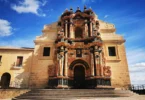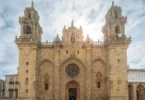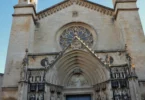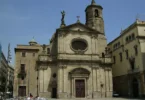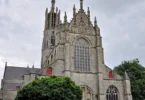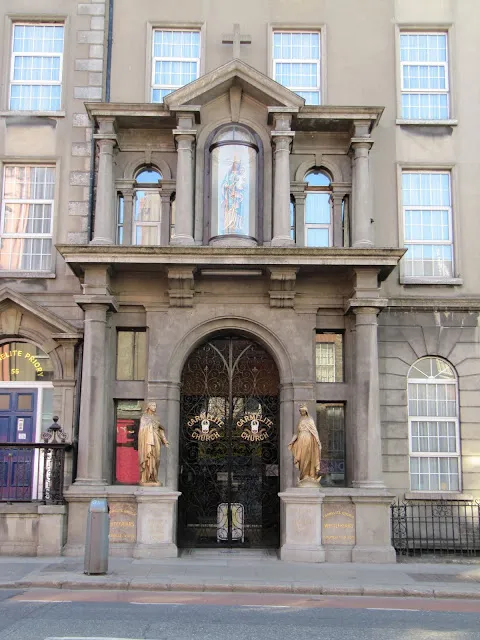
Introduction
Whitefriar Street Carmelite Church is a Roman Catholic church in Dublin, Ireland maintained by the Carmelite order. The church is noted for having the relics of Saint Valentine, which were donated to the church in the 19th century by Pope Gregory XVI from their previous location in the cemetery of St. Hippolytus in Rome.
The church is on the site of a pre-Reformation Carmelite priory built in 1539. The current structure dates from 1825 and was designed by George Papworth, who also designed St. Mary’s Pro-Cathedral in Dublin. It was extended and enlarged in 1856 and 1868
The church also contains relics of St. Albert, a Sicilian who died in 1306. On his feast day (7 August), a relic of the saint is dipped into the water of St. Albert’s Well, and the Carmelites say that those who piously use the water receive healing of both body and mind through the intercession of St. Albert.
The church also contains a life-size oak figure of Our Lady of Dublin. The 1825 building features in Fisher’s Drawing Room Scrap Book, 1833 as The Church of the Carmelite Friary., an engraving of a painting by George Petrie of the interior being accompanied by a poetical illustration by Letitia Elizabeth Landon.
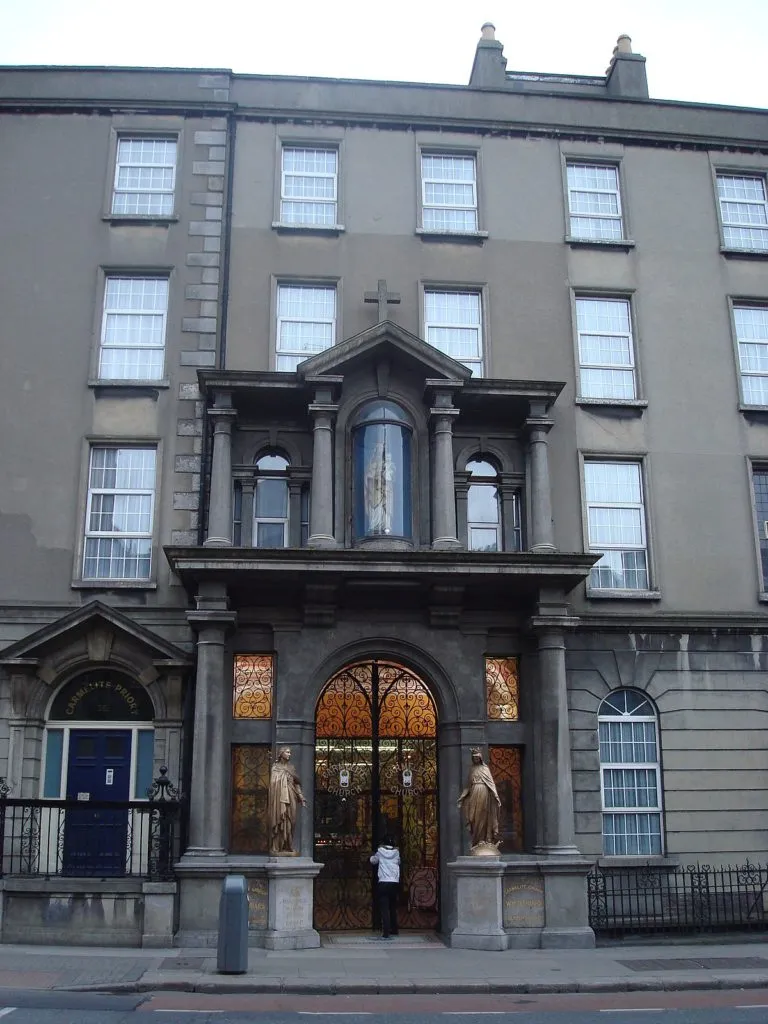
The first Carmelites arrived in Ireland in the 1270s, and established a friary at Leighlinbridge in Co. Carlow. In Dublin, Sir Robert Bagot, chief justice of the King’s Bench, built them a house in St Peter’s parish on the south side of the little walled city of Dublin. He had bought this bit of land (on which modern Whitefriars stands) from the Cistercian Abbey of Baltinglass in Co. Wicklow. The priory thrived but dark times were to come in the form of the Protestant Reformation during the sixteenth century. The suppression of the Irish houses began with places like White Abbey in Kildare town. Whitefriars, Dublin, was surrendered on August 3, 1539.
Early in the seventeenth century, the Carmelites were back in Dublin, and had established themselves in Cook Street. By 1728, the Carmelites had settled themselves in Ashe Street. They remained there, working amongst the Dublin people and in the surrounding districts, until the lease of their house expired and the landlord would not renew it. They then moved to a house in French Street (later called Upper Mercer Street) and built a chapel in Cuffe Lane close by. This was in 1806.
A Dublin youth, John Spratt, had, after being attracted to the Order at its Dublin chapel, gone to Spain and received the Carmelite habit in Cordova. When he returned, he came to the Dublin house, of which he was soon made prior. He set himself, like so many other Catholics at this time, to try to do something for the education of the children of the Catholic poor, and accordingly opened his first school in Longford Street in 1822. This was moved to a more spacious site in Whitefriar Street in 1824.
The Longford Street property had been part of medieval Whitefriars. Fr Spratt managed to acquire more of the old site. The Community moved to Whitefriar Street in 1825 and, a year later, the Archbishop of Dublin laid the foundation stone of the new church. The architect, George Papworth (1781-1855), was also the designer of Dublin’s St Mary’s Pro-Cathedral on Marlborough Street, and of a number of large country houses in Ireland. Although an account of the new building remarked that “the whole expense is about £4,000; and proves how much can be done with small means, when taste and judgment are combined,” the debt was a heavy one for the Irish Carmelites.
The Carmelite church in Whitefriar Street stands on the same site as their pre-Reformation Dublin Priory, though nothing remains of the older buildings. The church – dedicated to Our Lady of Mount Carmel – was consecrated on November 11, 1827.
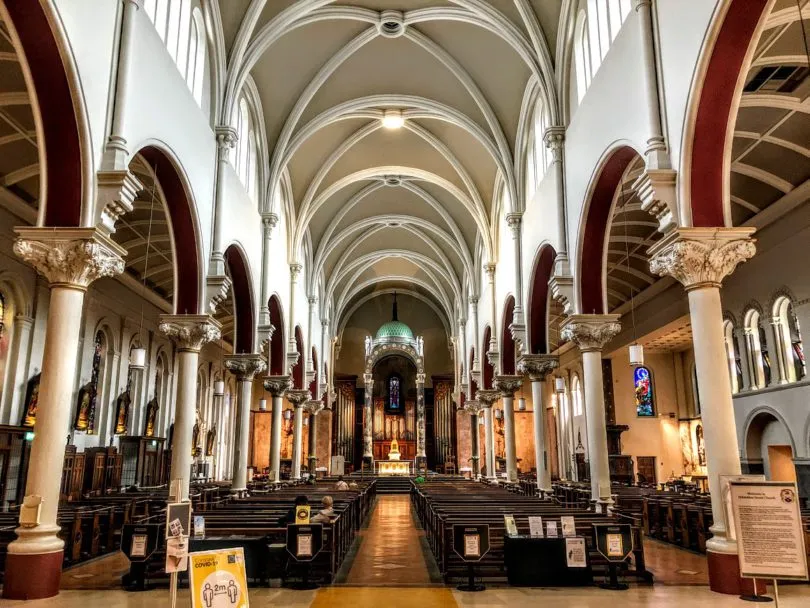
The church as we see it today is very different to that which was consecrated in 1827. All that is left of that structure is the outer wall on Whitefriar Place with its large bronze lettering just below the roof. By 1840, the building had proved to be too small for the congregation. The second stage of the development of this site took place in 1842, and mainly consisted of using the existing church as the south side of the new church, adding a new nave and north aisle.
This extension to the church firmly established it as one of the largest churches in the city on a very limited site, with the main approach from a narrow street that was rapidly dwindling in importance. The church as it is at present is virtually the same as it was in 1844, if we omit St Thérèse’s chapel, and place the high altar at the east end beneath the current gallery.
The next major work, the most recent, was undertaken by Rev. C. Haughey, O.Carm., in 1951. The entrances were inadequate and indirect – being concentrated in Whitefriar Street – while the great majority of traffic was coming from the opposite end behind the high altar. The solution was simple and direct, involving minor structural alterations only. The scheme reversed the church completely, placing the high altar at the west end and building on a sacristy. Now direct access was available from the main thoroughfare of Aungier Street.
In this entrance hallway was erected a life-size depiction of Calvary – a favoured place to pause and pray for so many visitors to the church. During the progress of this work it was decided to form a new chapel off the north aisle similar to the shrine of St Thérèse in Lisieux. To reproduce it exactly was impossible having regard to the cost, but the same feeling was contrived by adopting a similar shape and a simplified Romanesque style. Four altars are contained in this side chapel, each dedicated to saints of particular significance for us: St Valentine, St Jude, St Anne, and Pope St Pius X, and each saint are represented by a statue in a niche of gold mosaic over their altar. The Whitefriar Street complex is more than just a working church.
Stained Glass Windows
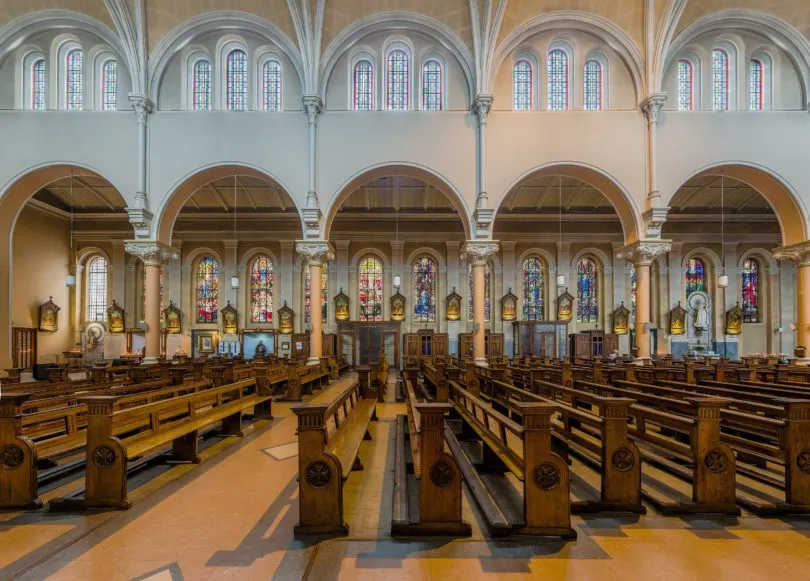
Due to the popularity of the various shrines in Whitefriar Street, including St Valentine and St Jude, one aspect that is often overlooked is the beautiful collection of stained glass windows in the church, some of which are nearly 140 years old. Some of the most beautiful are those depicting scenes from the life of Our Lady – the Rosary Windows – and those depicting The Process and Proclamation of the Dogma of the Immaculate Conception, all of which were restored in the 1990s.
The Immaculate Conception windows were originally crafted in the 1880’s by the renowned Franz Mayer & Company of Germany and are fine examples of what is known as the ‘Munich Style’ in stained glass. The Rosary windows were crafted in the 1930’s by Dubliners in the work-rooms of Earley & Company on nearby Camden Street. Apart from these spectacular sets, the church also contains many windows portraying Carmelite Saints, including the recently canonised Saint Nuno, and Saint Thérèse of Lisieux, among others.
There are also several windows depicting the Blessed Virgin Mary, who is a central figure in Carmelite Spirituality. Of particular note is the central window, over the organ, depicting Our Lady of Mount Carmel and the Christ Child Enthroned by Hubert McGoldrick (1897-1967), a member of the famous An Túr Gloine co-operative which also included artists such as Harry Clarke and Evie Hone.
The Pipe Organ
In the early 1980’s, Fr Christopher Crowley, O.Carm., the then Prior of Whitefriar Street, in consultation with the Carmelite Community, decided to install a pipe organ in our beautiful church. It was built by the renowned firm of Kenneth Jones & Associates of Bray, Co. Wicklow, who have also completed instruments for Dublin’s Christ Church Cathedral and National Concert Hall. A previous pipe organ had been replaced by an electronic instrument in the 1960’s. Much of the material in the Kenneth Jones instrument was new but historical pipework by noted nineteenth-century Irish organ builders, John White and William Telford, was also sourced.
The instrument we now have is one of the finest tracker action organs in Ireland. A tracker action organ is an instrument in which all the parts are mechanical and not driven by electricity. Electricity is used to power the wind blowing apparatus and the lights at the keyboard. All other connections between the pipes and the keys are achieved mechanically. In all, the organ contains over 2200 pipes, ranging from the size of a small pencil to pipes 16 feet in height.
Shrine of St. Valentine
Feast day: February 14
Throughout the centuries since Valentine received martyrdom there have been various basilicas, churches and monasteries built over the site of his grave. Therefore, over the years, many restorations and reconstructions took place at the site. In the early 1800’s, such work was taking place and the remains of Valentine were discovered along with a small vessel tinged with his blood and some other artefacts.
In 1835 an Irish Carmelite by the name of John Spratt was visiting Rome. Apparently his fame as a preacher had gone before him, no doubt brought by some Jesuits who had been in Dublin. The elite of Rome flocked to hear him and he received many tokens of esteem from the doyens of the Church. One such token came from Pope Gregory XVI (1831-1846) and were the remains of Saint Valentine.
On November 10, 1836, the Reliquary containing the remains arrived in Dublin and were brought in solemn procession to Whitefriar Street Church where they were received by Archbishop Murray of Dublin. With the death of Fr Spratt interest in the relics died away and they went into storage. During a major renovation in the church in the 1950s/60s they were returned to prominence with an altar and shrine being constructed to house them and enable them to be venerated. The statue was carved by Irene Broe and depicts the saint in the red vestments of a martyr and holding a crocus in his hand. Hand-painted replicas of this statue are available in our Church Shop.
Today, the Shrine is visited throughout the year by couples who come to pray to Valentine and to ask him to watch over them in their lives together. The feast-day of the saint, February 14, is a very popular one.
Shrine of Our Lady of Dublin
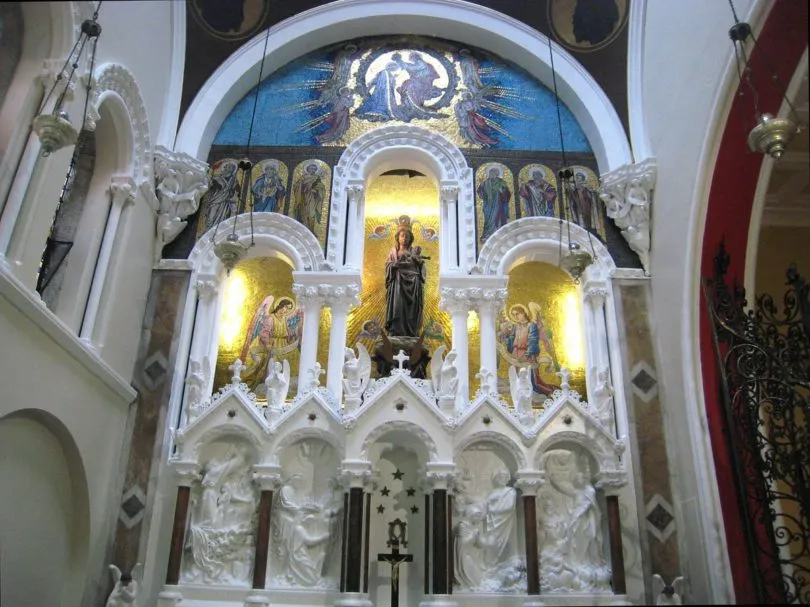
Feast day: September 8
Ireland is fortunate in that she still possesses a number of ancient wooden sculptures, including several of Our Lady and a few of the Irish saints. The oldest of these figures is the twelfth-century Madonna and Child from Kilcorban, Co. Galway. The figure venerated in the Carmelite church today under the title of “Our Lady of Dublin” has been compared in style to some of the early sixteenth-century sculptures in the Henry VII chapel at Westminster, and is probably of this period.
It is a life size figure in oak, showing Our Lady holding her Child. Originally brightly painted, the figure had been later whitewashed over and, unfortunately, the removal of the whitewash in 1914 also took off the ancient polychrome surface as well. The extended arm of the Child is a modern restoration. It is said that this statue originally belonged to St Mary’s Cistercian abbey on the north bank of the Liffey in Dublin. This abbey was frequently visited both by the English nobility and by royal officials from England who stayed there when in Dublin. Thus, it would not be surprising to find the Dublin Cistercians in possession of a statue belonging to the same school of art as some of the sculptures in Westminster Abbey.
St Mary’s was surrendered in 1539, at the Reformation, and the statue is said to have been used as a trough in an adjacent inn yard. It was common practice to hollow the backs of such wooden figures, both to reduce weight and prevent the wood warping and splitting; thus, laid face down, the figure could form a shallow trough for pigs. It is first mentioned in an account of the Catholic chapels of Dublin written by an unnamed Protestant in 1749. This states that “In Mary’s Lane is a parochial chapel whose jurisdiction extends from one side of Boot Lane to one side of Church Street. It is a large and irregular building.
On the Epistle side of the altar stands a large image of the Blessed Virgin with Jesus in her arms, carved in wood; which statue at the dissolution belonged to St Mary’s Abbey”. Mary’s Lane chapel was served by the Jesuits; its site is now occupied by a block of flats called St Michan’s House. In 1816, the old chapel was converted for use as a school and a new church erected in St Michan’s parish.
The whitewashed figure appears to have been discarded and found its way into a second-hand shop in Capel Street. Here, Fr Spratt of Whitefriars saw it in 1824 and immediately went in and purchased it, for a nominal sum. Although Dr Spratt saved the figure, the ancient silver crown that went with it was sold for the value of the metal and melted down.
The last account of the crown is given by the distinguished archaeologist Petrie, who saw it in a jeweller’s window waiting sale. He said that “it was a double arched crown such as appears on the coins of Henry VII and on his only: a circumstance which marks with exact precision the age of the statue which it had adorned”. Petrie’s dating of the crown, and thus the statue, corresponds with the dating of the statue on stylistic grounds by comparison with the work in Westminster Abbey.
But if the crown really belonged to the statue, it raises a grave doubt of the truth of the story of the use of the statue as a trough, and suggests rather that crown and figure were concealed together in some hiding place at the Reformation and subsequently restored for Catholic veneration to some Catholic chapel as soon as it was safe to do so. It may well have been venerated elsewhere before it appears in the Mary’s Lane chapel. Dr Spratt placed the statue on the Epistle side of the high altar in the new Whitefriars church. In 1915, after the figure had been cleaned, the shrine of Our Lady of Dublin was formally erected in the Carmelite church.
Shrine of St Thérèse of Lisieux
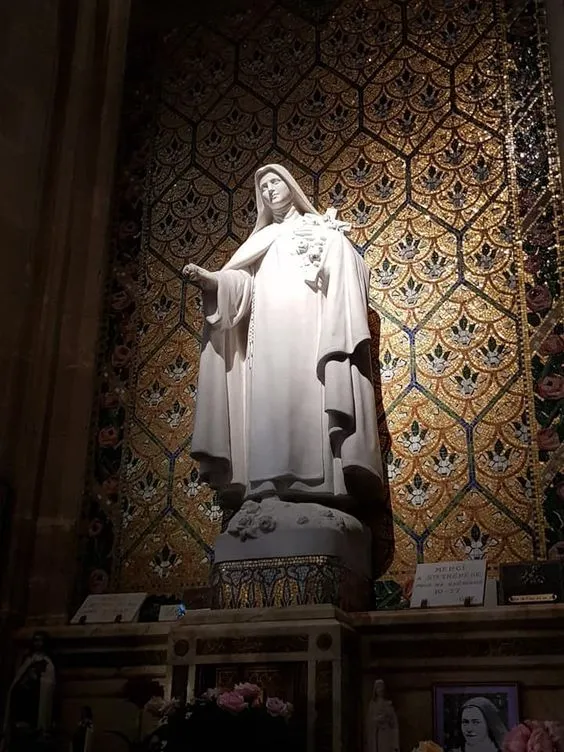
Feast day: October 1
The Shrine of St Thérèse in Whitefriars Street Church was blessed in September 1955 by the Rt. Rev Mgr Vernon Johnson of St James’, Spanish Place, London. The statue of the saint, designed in marble, is a replica of the statue of the saint over the High Altar in the crypt of the Basilica in Lisieux. It stands on its plinth with an impressive background which depicts, in mosaic, Our Lady of the Smile, which was originally designed for the Church of St Sulpice, Paris, by Bouchardon in 1750.
Shrine of St. Albert of Sicily
Feast day: August 7
St Albert of Sicily is one of the many famous saints of whom very little is known, the so-called “Lives” being merely collections of pious legend. He belongs to the thirteenth century and to the first period of Carmelite settlement and expansion in the west. He was born in Trapani in Sicily. This island was an obvious choice for the Carmelites, coming west from Palestine, in which to make a foundation. After his ordination, Albert was sent to the priory at Messina, also in Sicily, and this was the main centre of his life’s work.
St Albert typified the new kind of Carmelite that adaptation to the west produced, a man of prayer and penance, a lover of solitude, but also a man engaged in study and in the active apostolate. There were many Jews living in Sicily at this time, and Albert seems to have made them a special object, and been successful in making converts. He is also said to have written books, though none survive, and he is regarded as patron of Carmelite studies. Recognised as a wonder worker during his lifetime, miracles and cures continued to be attributed to Albert’s intercession after his death. His cult spread quickly through the whole of the Order.
The celebration of his feast, on 7th August, was introduced into the Carmelite rite in 1411. A relic of the saint is dipped in the water and a prayer said in which St Albert’s intercession is asked for all who use the water; that they will gain healing of body and soul thereby. Dr Spratt who had lived in a priory dedicated to St Albert in Spain, brought the devotion back to Ireland, and to the new Whitefriar Street church, in which he inaugurated the well of St Albert.
Shrine of Calvary
The Calvary Shrine is to be found in the entrance hallway to the church coming in the main door from Aungier Street. The scene depicts life size statues of Our Lord upon the Cross with his Mother and the disciple he loved looking up at him. At the foot of the Cross kneels Mary of Magdala. The scene is raised up on a stone plinth before which people place their lighted candles.
Shrine of the Sacred Heart
Feast day: The third Friday after Pentecost Sunday
Devotion to the Sacred Heart (also known as the Most Sacred Heart of Jesus) is one of the most widely practiced and well-known devotions, taking Jesus Christ’s physical heart as the representation of his divine love for humanity. The devotion especially emphasizes the unmitigated love, compassion, and long-suffering of the heart of Christ towards humanity. The origin of this devotion in its modern form is derived from a Roman Catholic nun from France, Marguerite Marie Alacoque, who said she learned the devotion from Jesus during a series of apparitions which occurred between 1673 and 1675.
The Sacred Heart is often depicted in Christian art as a flaming heart shining with divine light, pierced by the lance-wound, encircled by the crown of thorns, surmounted by a cross and bleeding. Sometimes the image is shown shining within the bosom of Christ with his wounded hands pointing at the heart. The wounds and crown of thorns allude to the manner of Jesus’ death, while the fire represents the transformative power of divine love. The Feast of the Sacred Heart has been in the Roman Catholic liturgical calendar since 1856, and is celebrated 19 days after Pentecost. As Pentecost is always celebrated on a Sunday, the Feast of the Sacred Heart always falls on a Friday. The Shrine is located to the left of the main altar and contains its own altar
Shrine of Our Lady of Lourdes
Feast day: February 11
From February 11 to July 16, 1858, fourteen-year-old Bernadette Soubirous received visions from Our Lady near the mountain village of Lourdes, in south-western France. Initially, people refused to believe her, but the apparitions continued. When Bernadette asked the Lady who she was the Lady replied that she was the Immaculate Conception, and this came just four years after the dogma had been declared by Pope Pius IX. In time the well and site of the apparition became a centre of prayer as people flocked to it to draw closer to Our Lady and in the hope of receiving a cure. Several miracles have taken place there and, in recognition of this, Pope John Paul II named February 11 as ‘World Day of the Sick’ in 1992. On the feast day, special liturgies may be celebrated which include the Sacrament of the Anointing of the Sick.
The Shrine of Our Lady of Lourdes is located on the left as one enters the main body of the church at Whitefriar Street. It extends from floor to ceiling and depicts the young Bernadette kneeling and looking up at Our Lady as she appeared to her.
Shrine of Our Lady of Fatima
Feast day: May 13
In 1913, Our Lady appeared to three peasant children – Lúcia dos Santos and her cousins Francisco and Jacinta Marto – outside the village of Fatima in Portugal. The apparitions began on May 13 and ended on October 13. Francisco and Jacinta died in 1919 and 1920 respectively because of the flu pandemic and were canonized in 2017. Lúcia entered religious life, first with the sisters of St Dorothy, and then the enclosed Order of Discalced Carmelites at Coimbra, Portugal, where she would spend the rest of her life. She died in 2005 aged 97. The Shrine can be found to the left of the main sanctuary in the church.
Shrine of St. Michael the Archangel
Feast day: September 29 (with the Archangels Gabriel and Raphael)
The three archangels are the senior angels who dwell in God’s presence and who act on his behalf in relations with his people. Michael is traditionally regarded as the chief of the Archangels and a special protector against the attacks of Satan. Gabriel is the special messenger of the Lord who visited Mary at the Annunciation. Raphael is known as ‘The Healer of the Lord’ because he brought healing to people as found in the Book of Tobias and St John’s Gospel. The shrine to St Michael is inside the main door of the church.
Shrine of Pope St. Pius X
Feast day: August 21
August 21 is the memorial of Pope St Pius X. Giuseppe (Joseph) Sarto was born in 1835 and was ordained priest in 1858. He was made Bishop of Mantua in 1884 and eight years later was created Cardinal Patriarch of Venice. In 1903 he was elected Pope.
During his pontificate he urged daily Communion and facilitated the Communion of children and the sick. One of those who influenced him in this was an Irish girl named Ellen Organ from Co Waterford, commonly known as Little Nellie of Holy God. Ellen died in the care of the Good Shepherd Sisters in Cork in 1908 at the age of four years and six months, but in those short years she was known to be spiritually very aware and longed to receive Holy Communion, which she did by special permission in 1907. The story of her life became known to the pope who took it as a sign that he should lower the age at which children could receive Holy Communion, and so he did. Pius X also encouraged Bible reading and tackled Modernism. He died in 1914 and was canonized forty years later.
Shrine of St. Anthony
Feast day: June 13
June 13 is the memorial of St Anthony of Padua, Priest and Doctor of the Church. Anthony was born in Lisbon, Portugal, in 1195. He first joined the Augustinian Canons Regular but later left to become a Friar Minor of St Francis. He was known to his contemporaries as “The Hammer of Heretics” for his dedicated preaching of the true faith. He has a reputation for retrieving lost objects of careless people. He died in 1231 and was canonized a year later in 1232, and was declared a Doctor of the Church in 1947.
Shrine of The Infant of Prague
The Infant Jesus of Prague is a sixteenth century Roman Catholic wax-coated wooden statue of the Child Jesus holding a globus cruciger (an orb surmounted by a cross), located in the Carmelite Church of Our Lady Victorious in Malá Strana, Prague, in the Czech Republic.
Pious legends claim that the statue once belonged to Saint Teresa of Avila and allegedly holds miraculous powers, especially among expectant mothers. The statue is known worldwide in relation to earlier child Jesus’ icons, most prominently the Santo Nino de Atocha in Spain and Latin America (thirteenth century), the Santo Nino de Cebu (1521) in the Philippines, and recent ones such as the Holy Infant of Good Health (from Mexico, 1939), and the Divino Niño (from Colombia, 1940’s).
Shrine of Blessed Titus Brandsma
Feast day: July 27
Blessed Titus Brandsma joined the Carmelite Order as a young man. Ordained priest in 1905, he obtained a doctorate in philosophy in Rome. During the 1930’s, he visited Ireland and stayed in Kinsale with the Carmelite Community there to improve his English before giving a series of lectures in the United States. Both before and during the Nazi occupation of The Netherlands he fought, faithful to the Gospel, against the spread of the Nazi ideology and for the freedom of Catholic education and the Catholic press. For this he was arrested and sent to a succession of prisons and concentration camps where he brought comfort and peace to his fellow prisoners and did good even to his tormentors. In 1942, after much suffering and humiliations, he was killed at Dachau. He was beatified by John Paul II on November 3rd, 1985.
Shrine of St. Joseph
Feast day: March 19
St Joseph, Husband of the Blessed Virgin Mary, Protector of the Child Jesus. He was a man of faith who played his role in God’s salvific plan for us; he was obedient to the will of God; he had a love for the Law and its fulfilment; he showed piety and fortitude in times of trial; he had a chaste love for the Blessed Virgin Mary and he exercised his paternal authority with due care. He is, therefore, a true example of Christian living and is the Protector of the Church and of the Carmelite Order. Joseph is also the patron of carpenters and manual workers.
Shrine of St. Anne
Feast day: July 26
We know nothing definitively about the parents of the Mother of God. One of the apocryphal gospels says that they were named Joachim and Anne, and goes on to relate that Mary was the child of old age and the prayers of parents who, until then, had not been blessed with children. The feast of Our Lady’s (Immaculate) Conception was observed by the East long before the West, and in the Byzantine calendar it is kept on December 9 and titled the feast of St Anne’s Conception of the mother of God. As the Carmelites came from the east to the west, it is not surprising to find that devotion to St Anne is a feature of Carmelite life, and that they helped forward it in Europe.
Her feast is included in the two earliest Carmelite ordinals, and the General Chapter of 1375 ordered a daily commemoration to be made of her in the liturgy. In the Western Church as a whole, the devotion spread slowly; taking root in some areas early, in some late. Probably under Eastern influence, she appears in an eighth century fresco in Rome in the ruined church of S. Maria Antiqua in the Forum. But it was not until 1382 that her feast was introduced into the general calendar of the Latin Rite in the West.
The Normans seem to have been attracted to St Anne early on and brought the devotion to Ireland. It was strong in Dublin in the Middle Ages and, elsewhere in Ireland, some ancient holy wells were rededicated to St Anne. A fine example is St Anne’s well at Tomhaggard in Co. Wexford, where, in recent years, the well has been made the centre of a beautiful shrine and the ancient pattern (pilgrimage) in St Anne’s honour, restored. Brittany too, was an early centre of devotion to St Anne d’Auray (25-26 July) and Sainte Anne la Palud (23-24 August) are among the most famous and well-attended of the traditional Breton pilgrimages. St Anne, grandmother of Christ, is, of course, very specially the patron of all Catholic wives and mothers.
Our Lady of Mount Carmel
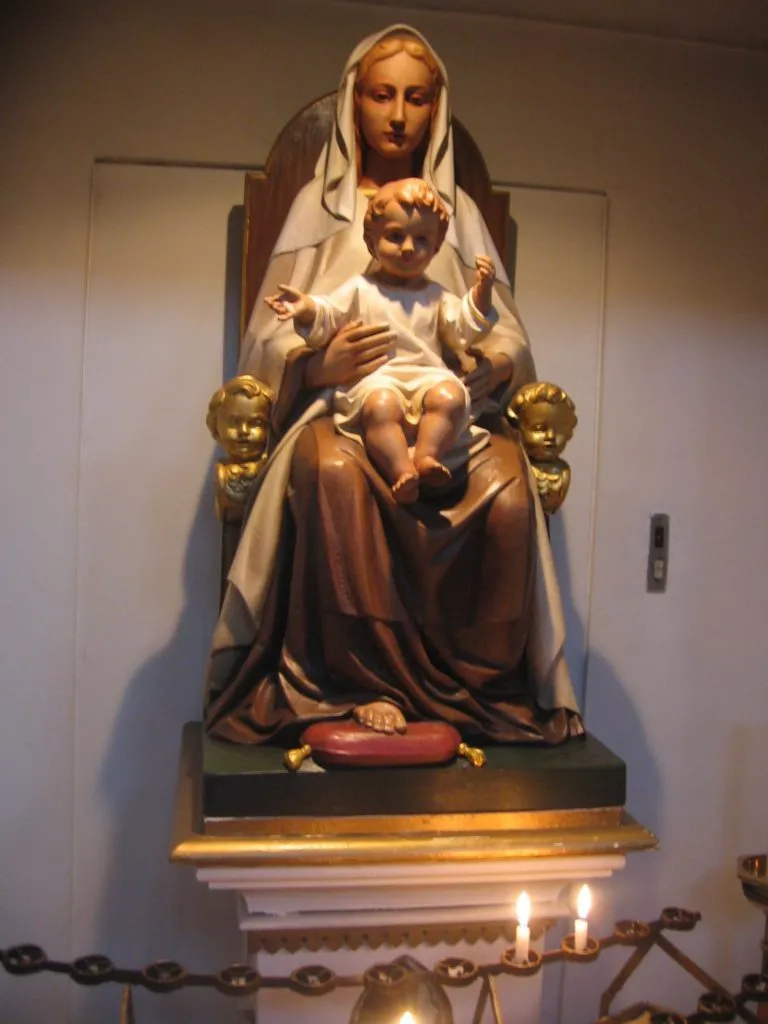
Feast day: July 16
The Sacred Scriptures speak of the beauty of Mount Carmel where the Prophet Elijah defended the faith of Israel in the living God. There, at the beginning of the thirteenth century, under the title of “Brothers of Our Lady of Mount Carmel”, the Order of Carmelites had its formal beginning.
From the fourteenth century this title, recalling the countless blessings of its patroness, began to be solemnly celebrated, first in England and then gradually throughout the whole Order. It attained its supreme place from the beginning of the seventeenth century when the General Chapter declared it to be the principal feast of the Order, and Paul V recognised it as the feast of the Scapular Confraternity.
Shrine of St. Jude
Feast day: October 28
The brief letter (Epistle) of St Jude in the New Testament is the principal means by which we can come to know the saint. It seems to have been written to meet the same crisis in the early Church as St Peter’s second Epistle, the two letters contain similar material and warnings. Just because we know so little for certain about the careers of the different Apostles, legend and invention soon built-up stories of their lives. There is a legend of St Jude, purporting to give an account of his missionary activities and martyrdom, but it would be foolish to give much credence to it. There may, however, be a real tradition at the back of the stories about the different countries in which the Apostles worked that these were the areas or directions into which each penetrated. Thus, St Simon and St Jude are said to have travelled to Persia and to have suffered martyrdom there; they share the same feast-day in the Church’s calendar, on 28th October. But nobody seems to know how St Jude came to be the saint to whom people pray for apparently hopeless cases.
Shrine of Blessed Titus Brandsma
Feast day: July 27
Blessed Titus Brandsma joined the Carmelite Order as a young man. Ordained priest in 1905, he obtained a doctorate in philosophy in Rome. During the 1930’s, he visited Ireland and stayed in Kinsale with the Carmelite Community there to improve his English before giving a series of lectures in the United States. Both before and during the Nazi occupation of The Netherlands he fought, faithful to the Gospel, against the spread of the Nazi ideology and for the freedom of Catholic education and the Catholic press. For this he was arrested and sent to a succession of prisons and concentration camps where he brought comfort and peace to his fellow prisoners and did good even to his tormentors. In 1942, after much suffering and humiliations, he was killed at Dachau. He was beatified by John Paul II on November 3rd, 1985.
Shrine of St. Joseph
Feast day: March 19
St Joseph, Husband of the Blessed Virgin Mary, Protector of the Child Jesus. He was a man of faith who played his role in God’s salvific plan for us; he was obedient to the will of God; he had a love for the Law and its fulfilment; he showed piety and fortitude in times of trial; he had a chaste love for the Blessed Virgin Mary and he exercised his paternal authority with due care. He is, therefore, a true example of Christian living and is the Protector of the Church and of the Carmelite Order. Joseph is also the patron of carpenters and manual workers.
Relics
The church is noted for having the relics of Saint Valentine, which were donated to the church in the 19th century by Pope Gregory XVI from their previous location in the cemetery of St. Hippolytus in Rome. On November 10, 1836, the Reliquary containing the remains arrived in Dublin and were brought in solemn procession to Whitefriar Street Church where they were received by Archbishop Murray of Dublin. With the death of Fr Spratt interest in the relics died away and they went into storage. During a major renovation in the church in the 1950s/60s they were returned to prominence with an altar and shrine being constructed to house them and enable them to be venerated.
The church also contains relics of St. Albert, a Sicilian who died in 1306. On his feast day (7 August), a relic of the saint is dipped into the water of St. Albert’s Well, and the Carmelites say that those who piously use the water receive healing of both body and mind through the intercession of St. Albert.
Annual Feast Day
The feast day of Our Lady of Dublin is celebrated on 8th September each year which is also the date of the Birthday of Our Lady.
Mass Timing
Sunday Masses
8.00am, 10.30am, 12.30pm and 4.00pm. The Vigil Mass is Saturday at 6pm
Weekday Masses
8.00am, 10.00am, 11.30am, and 3.00pm
Masses on Holy Days
According to the day of the week
Masses on Bank Holidays
10.00am and 11.30am
Contact Info
56 Aungier Street
Dublin, D02 YF57
Ireland
Phone No.
Accomodations
How to reach the Sanctuary
Airways
The nearest airport to the Whitefriar Street Carmelite Church is Dublin Airport (DUB) which is just 15 kilometres away from the Basilica.
Railways
The nearest railway station to the Whitefriar Street Carmelite Church is St. Stephen’s Green(LUAS) which is just 600 metres away from the Basilica.


